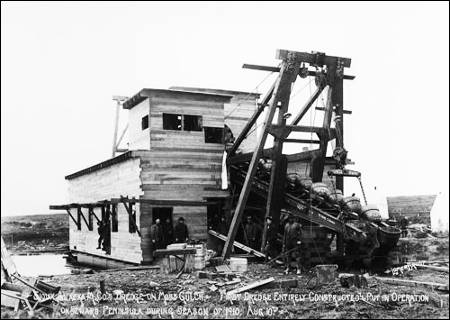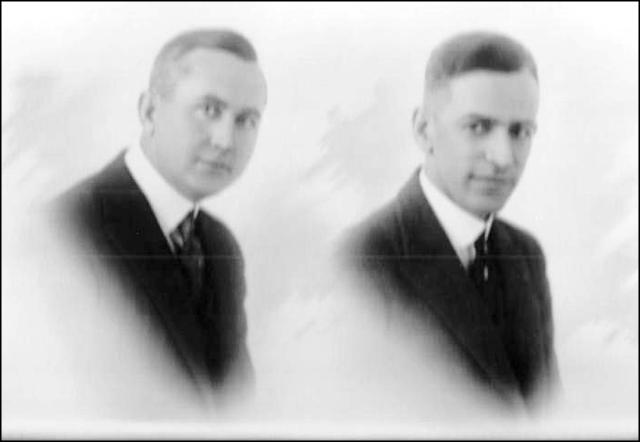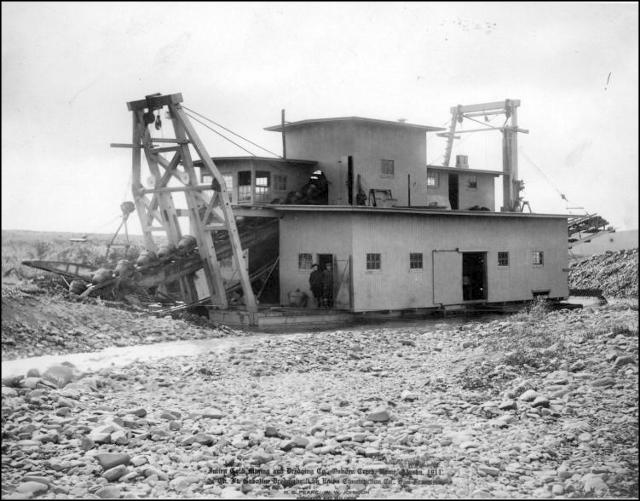Walter W. Johnson
(1886 - 1971)

Walter Johnson at Cottonwood Camp, Seward Peninsula, circa early 1900s.
Source: LynnJohnson
Walter W. Johnson, Alaska gold dredge pioneer, was born on August 3, 1882 in Farmer City, Illinois. He was the fifth of nine children born to Perrin Eskew and Eva Clifford Williams Johnson. In 1898, the Johnson family moved from Farmer City to nearby LeRoy where Perrin found work as a butcher in the local market. Walter attended Empire Township High School where he excelled in both academic and athletic pursuits. His mechanical engineering gifts were soon recognized, and he was pulled out of school on more than one occasion to fix problems with the city's power plant. Due to the family's modest circumstances, Walter worked on his uncle's farm after school and during the summer in order to save money for college. After graduating from high school, he studied mechanical engineering and mining engineering at the University of Illinois.

Walter Johnson in football uniform, who valued physical fitness and healthy eating habits. He exercised religiously all his life.
Photo courtesy of W. W. Johnson Collection
In 1905, Johnson took a train to California where he found employment in the Natomas Company's Folsom gold dredging operations. His fiancée, Pearl Elizabeth Clarey, also from LeRoy, followed him to California, and they were married in Sacramento on November 6th, 1905. Walter and Pearl had four sons, Thomas Keith, born in 1908, Paul Warren, born in 1910, Walter Scott, born in 1919, and Phillip Clarey, born in 1921. Three of their sons eventually worked in the family gold dredging business which, by the mid 1930s, was known as the Walter W. Johnson Company.
Johnson began designing dredges as early as 1906, and over the course of his long career, built a total of 58 gold and tin dredges in places such as Alaska, California, Canada, Siberia, Thailand, Portugal, Bolivia and perhaps elsewhere. Thirty two of the 58 dredges were built for mining placer deposits in Alaska, and Johnson is credited with building more dredges in Alaska than any other dredge manufacturing company.
By 1909, Johnson, now living in Berkeley, California, was building dredges both as an employee of the Judson Manufacturing Company and as co-owner of the Northern Dredge Building and Construction Company (Nome Nugget Mining and Dredging Edition, October 1910:36; Spence 1996:33; Gibson 1911:18). On June 2, 1910, Johnson, now 27 years old, sailed from San Francisco to Nome on the steamship Umatilla with parts for three dredges slated for installation in the Nome Mining District, including one for the Arctic Gold Dredging Company, managed by Frank Middaugh, and one for the Sioux-Alaska Mining Company, managed by Colin Murray (San Francisco Call, June 3, 1910; Gibson 1911:18). Parts for both dredges were manufactured at Union Iron Works, a San Francisco Bay Area company. Johnson spent the 1910 season on the Seward Peninsula engaged in the construction of several dredges, but also found time to prospect for claims on which he would soon operate his own dredges.
After returning to the San Francisco Bay Area in the fall of 1910, Johnson entered into a partnership with Harry Garfield Peake. The two men formed the Union Construction Company, with headquarters in San Francisco. Johnson was President and manager of field operations and Peake, formerly the chief engineer for the Yuba Manufacturing Company and the Boston Machine Shop, as well as a draftsman for the Bucyrus Company, was Vice President and manager of the engineering department (Mining and Scientific Press, January 14, 1911).
Johnson returned to Nome in 1911 and built two more dredges that year, including a gold dredge for the Julien Gold Mining and Dredging Company and a dredge for mining placer tin for the York dredging company, the first of several dredging companies he would own in Alaska. Parts for the Julien dredge were made at the Judson Manufacturing Company works in California and transported by steamship to Nome. Wood for the hull was picked in Seattle on the way. Johnson arrived at Nome on June 13th, arranged for the transport of the Julien dredge parts to Osborn Creek, a tributary of the Nome River, the same day. The dredge was constructed in record time under the personal supervision of Johnson, and was put into operation on July 22nd. The Union Construction Company soon became well respected for their efficiency in erecting small, specially-designed, bucket-line dredges that were well suited for mining the shallow placer deposits typically found along stream courses on the Seward Peninsula (Mining and Scientific Press, October 14, 1911, January 6, 1912; Janin 1912; Spence 1996:33). The company was the first to introduce the use of internal combustion engines on small dredges in Alaska, and made a number of other noteworthy modifications that allowed Union Construction Company dredges to operate more efficiently in the harsh conditions in Alaska.

Lomen Bros. photo of Sioux-Alaska Company's 2½-cu. ft. open-connected gasoline-driven dredge on Moss Gulch, a tributary of the Nome River, August 10, 1910. This was the first dredge entirely constructed and put in operation on Seward Peninsula during the 1910 season.

Walter W. Johnson (left) and Harry G. Peake (right), founders of the Union Construction Company

Julien Gold Mining and Dredging Company, Osborn Creek, Nome, Alaska. This 2¾-cu. ft. gasoline-powered dredge was designed and built in 1911 by the Union Construction Company.
Photo from the Carrie McLain Collection courtesy Carrie McLain Museum, Nome, Alaska.

Walter W. Johnson and his pupmobile on a trip from Nome to Shelton, the terminus of the narrow gauge railroad tracks, in 1912. The dogs pulled the pupmobile on level or uphill ground, but would jump onboard without command when the vehicle began to coast downhill. Johnson also traveled by boat, on horseback, and on foot when prospecting or visiting the various dredging operations.
Johnson's York Dredging Company dredge was the first placer-tin dredge built in the western hemisphere (Eddy 1911; Peake 1911). The machinery and buckets for this dredge were also made at the Judson Manufacturing Company works. The hull was framed in Seattle and then disassembled for shipment. The steamship carrying the machinery and lumber arrived in Nome on August 3, 1911. Johnson had made prior arrangements with the steamship company to pick up the construction crew and extra teams for hauling at Nome and transport the men, horses, and cargo to York, the port nearest the dredge site on Buck Creek. The roadstead at York is very shallow, so the steamship had to anchor three or four miles from shore. The freight was transferred to lighters and carried as near to the shore as possible. The cargo was transferred the remaining 300-200 feet to shore by wagons. A wagon-road had previously been constructed for the 14-mile haul to the dredge site. Construction of the dredge began on August 7th and was completed on September 6th.

The York Dredging Company's placer tin dredge on Buck Creek, York, Alaska, 1911.
Photograph by W.W. Johnson.
In 1912, Walter Johnson sailed from San Francisco to Nome with parts for five new dredges and seventy mechanics to install them. This time he also brought along his wife Pearl and two young sons, Keith and Paul. Four of the five dredges shipped to Alaska in 1912 were installed that summer, including a 3-cu. ft. dredge for the Pasadena Gold Dredging Company on Budd Creek in the Port Clarence Mining District; a 3-cu. ft. dredge for the Inmachuck Dredging Company on the Inmachuck River in the Fairhaven Mining District; a 2¾-cu. ft. dredge for the Ruby Dredging Company on the Casadepaga River in the Solomon Mining District; and a 1¾-cu. ft. dredge for the Candle Creek Dredging Company on Candle Creek in the Candle Creek Mining District. In addition to arranging for the transportation of men, machinery, materials, and supplies to the dredge sites and checking up on the progress of construction, Johnson also spent time overseeing the operation of his tin dredge.
The Union Construction Company eventually established an office on Front Street in Nome and the Johnson family rented a house at the edge of town on a spur of the railroad track. For the next few years, the family sailed from San Francisco on the first steamship bound for Nome and returned to California on the last ship to depart before freeze-up.
The Union Construction Company designed and built at least eleven more dredges in Alaska between 1913 and 1918. The company continued to install dredges on the Seward Peninsula, but by 1914 was also shipping dredges to the Alaska Interior. Dredges were installed on the Seward Peninsula during this six-year period for the Ernst-Alaska Gold Dredging Company, the only company to successfully dredge the beach sands at Nome, for Iver Johnson on the Kugruk River, for the Bangor Dredging Company on Bangor Creek, for the Behring Dredging Company on the Kougarok River, for Guinan and Ames on Glacier Creek, and for the Uplift Mining and Dredging Company on Camp Creek, a tributary of the Niukluk River. During this time period Johnson was also contracted with dredging companies to make improvements to dredges that had been built by other manufacturing companies, and he was also contracted to move dredges built by Union Construction and other companies and reconstructed them on new placer ground.

From left to right, Pearl Johnson, Paul Johnson, Keith Johnson and friends on the beach at Nome, circa 1913
Photo ???

The Arctic Gold Dredging Company's dredge on Hobson Creek. The machinery from the company's original dredge, built by the Union Construction Company on Grass Creek in 1910, was moved to the junction of Nome River and Hobson Creek in 1914 and installed on a new hull. The Union Construction Company was in charge of this work. Water for the dredging operation was obtained from the Miocene Ditch.
W.W. Johnson Family Photograph Collection
Transportation difficulties hampered dredge installation and increased the cost of dredging on the Seward Peninsula, and Johnson lamenting the lack of good roads in the 1916 Mining and Dredging Edition of the Nome Nugget.
The Union Construction Company also shipped six dredges to the Alaska Interior between 1913 and 1918, including the C.J. Berry dredge on Mastodon Creek in the Circle Mining District, the Beaton & Donnelly and Riley & Marston dredges on Otter and Black Creeks near Flat, the Guggenheim's Yukon Gold Company dredge on Greenstone Creek near Ruby, the Kuskokwim Dredging Company dredge on Candle Creek in the McGrath Mining District, and the Fairbanks Gold Dredging Company's dredge on Fairbanks Creek in the Fairbanks Mining District. Parts for some of these dredges were transported by steamship from San Francisco to St. Michael and then loaded onto barges that were pushed upriver by sternwheel steamers. The cargo was landed at the Yukon River port closest to the placer mining claim and was typically transported by teams to the dredge during winter, as it was much easier to move the heavy machinery over frozen ground.
By 1915, the Johnson Family was sailing from San Francisco to Skagway where they boarded the White Pass and Yukon Railway's narrow-gauge train to Whitehorse, a port on the Yukon River in Yukon Territory, Canada, and the terminus of the railroad. At Whitehorse the Johnsons boarded a sternwheel steamer bound for St. Michael on the Bering Sea at the mouth of the Yukon River. Union Construction Company dredges were eventually delivered to the Interior along this route.

Advertisement for the Union Construction Company published in the January 1, 1916 edition of Mining and Scientific Press. In addition to dredges, the company sold Neill jigs, semi-diesel engines, and Union prospecting drills, and also acted as agents for the Bucyrus Company.

Sternwheel steamer Louise pushing barges laden with cargo up the Yukon River from St. Michael.
Lomen Brothers photo from the Walter W. Johnson Family Collection

Walter W. Johnson (left) with his horses at a mining camp circa 1916. As reported in the December 23, 1916 edition of the Engineering and Mining Journal, Johnson had recently returned to San Francisco from Alaska where he had visited Dawson, Fairbanks, Tanana, Iditarod, Black, Otter, and Flat creeks, Kuskokwim River, Rock Creek, and Buck Creek, in addition to looking after the operations of other dredges built by the Union Construction Company.
Photo from Walter W. Johnson Family Collection
In 1918, at age 36, Walter Johnson and his partner H.G. Peake constructed a shipyard and manufacturing plant in Oakland on the shore of San Francisco Bay. The focus of Union Construction Company shifted to building ocean going vessels, and between 1919 and 1923 the company built ten freighters, four Coast Guard cutters, one Coast Guard tugboat, and six oil tankers, but apparently also built a dredge for mining placer tin in Bolivia.

Advertisement for the Union Construction Company published in the January 1922 edition of Pacific Marine Review.
The Union Construction Company's manufacturing plant was destroyed by fire in 1925 and Johnson and Peake eventually dissolved their partnership and by 1935 had formed their own companies, the Walter W. Johnson Company and the H.G. Peake Engineering Company. Johnson entered the ship scrapping business, but between 1935 and 1946 also designed and built seven additional dredges for Alaska. Three of these dredges were built for other companies, including the dredge on Coal Creek for Gold Placers, Inc., the dredge on nearby Woodchopper Creek for Alluvial Golds, Inc., and the dredge on Deadwood Creek for the Deadwood Mining Company. In 1942, Johnson also built a dredge in Yukon Territory, Canada, for Clear Creek Placers; this dredge is now owned by Tony Beets and is featured on the TV show Gold Rush
Four of the seven Alaska dredges built during this same time period were owned and operated by the Walter W. Johnson Company, including the Brinker-Johnson dredge on Caribou Creek, the Bristol Bay Mining Company dredge on Wattamuse and Slate creeks, the Boundary Dredging Company dredge on Canyon Creek, and the Johnson-Pohl dredge in Rocker Gulch on the outskirts of Nome.
The dredge on Coal Creek, in Yukon-Charley National Preserve, has been restored and is maintained by the National Park Service as a National Historic Site. The Johnson-Pohl dredge, also known as the Swanberg dredge, was a financial disaster for Johnson and is now owned and preserved by the City of Nome.
Walter W. Johnson remained active in the gold dredging industry into his 80s, making two trips to Alaska, the Yukon Territory, and British Columbia in 1964 at age 82. He retired in 1970, and passed away in Oakland, California on April 5th, 1971. Johnson passed his love for Alaska on to his grandchildren.
-
The Swanberg Dredge.
Photograph by Lynn Johnson

The Julien Gold Dredging Company dredge, 2013. The dredge was built on Osborn Creek, a tributary of the Nome River, by the Union Construction Company in 1911.
Photograph by Lynn Johnson
Many of the dredges constructed by Walter W. Johnson have been destroyed and others are suffering from the ravages of time. Lynn Johnson, the author of this biographical sketch, is attempting to locate any remaining dredges her built in Alaska by her grandfather.
Written by Lynn Johnson, March 28th, 2016
References
Eddy, Lewis H., 1911 A California Dredge for Alaska Placer Tin. The Engineering and Mining Journal, Vol. 92, No. 3 (July 15, 1911), pages 107-108.
Gibson, T. M., 1911 Nome Dredges in 1910. Mining and Scientific Press Vol. 102, No. 1 (7 January 1911), pages 18-25.
Gibson, T. M., 1912 Gold-Dredging Industry on Seward Peninsula. Mining and Scientific Press Vol. 104, No.1 (January 6, 1912), pages 45-48.
Janin, Charles, 1911 Present Day Problems in California Gold Dredging. Mining and Scientific Press Vol. 103, No. 16 (Oct. 14, 1911), pages 474-478.
Janin, Charles, 1912, Gold Dredging on the Seward Peninsula. Mining and Scientific Press Vol. 105, No. 13 (September 28, 1912), pages 394-399.
Mining and Scientific Press Vol. 102, No. 2 (Jan. 14, 1911), pg. 126. "Commercial Paragraphs."
Nome Nugget Mining and Dredging Edition, October 1910:36
Peake, H.G., 1911 Tin Dredging in Alaska. Mining and Scientific Press Vol. 103, No. 21 (November 18, 1911), pages 652.
San Francisco Call, June 3, 1910
Spence, Clark C., 1996, The Northern Gold Fleet: Twentieth-Century Gold Dredging in Alaska. University of Illinois Press, Urbana and Chicago, 302 pages.
